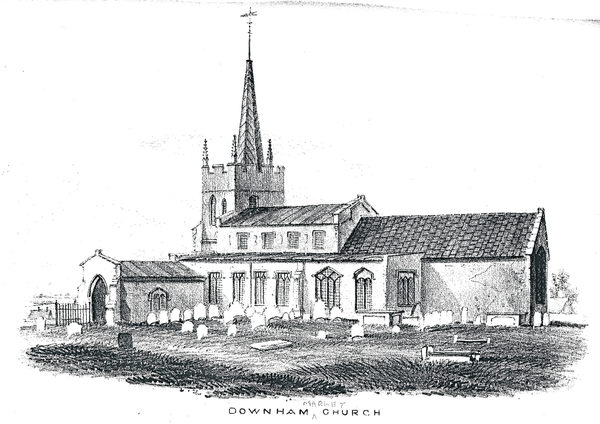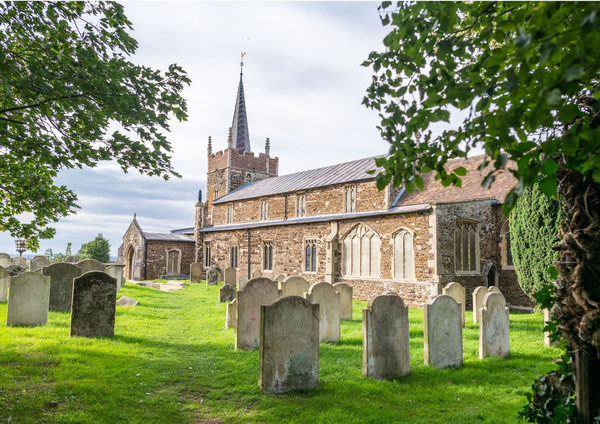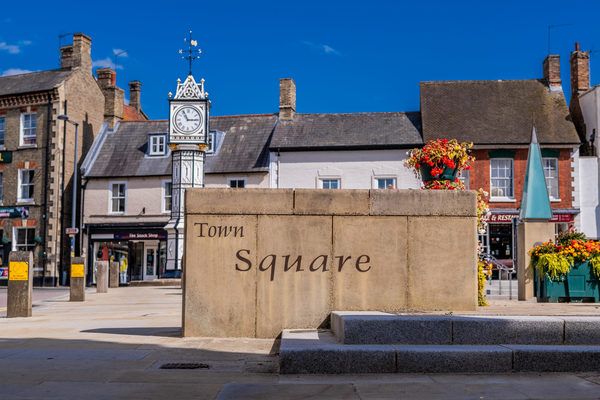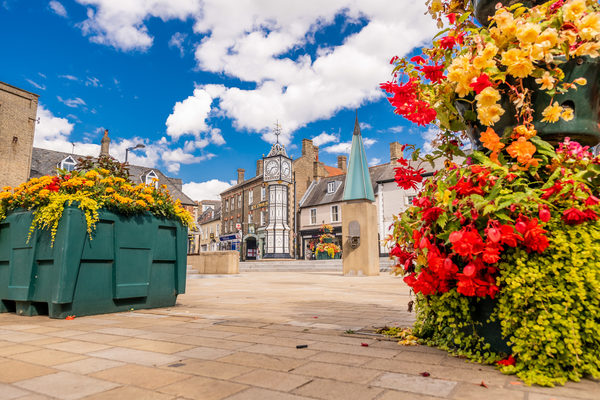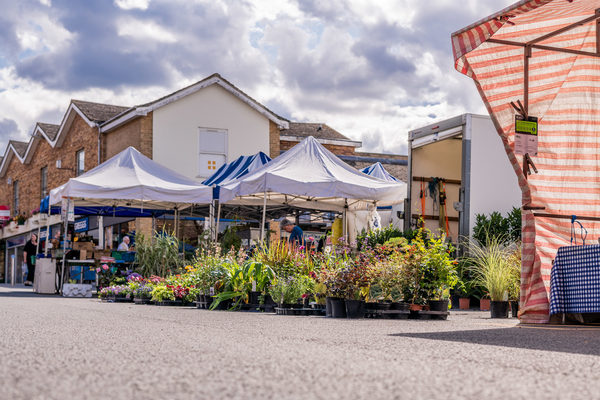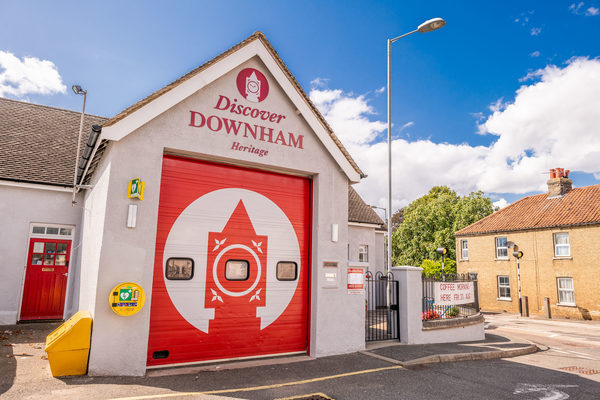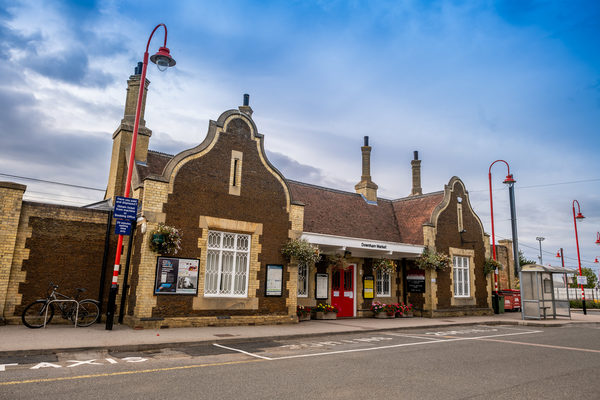St Edmund's Church, Downham Market. This church was built of local carrstone, which occurs in a narrow strip of land from here to Hunstanton. The quoins are constructed of ashlar, which has a contrasting colour, effectively accentuating the features. Standing on a crest of a hill it commands a fine view of the town and the fenland landscape beyond. This site was chosen for the church long before the present building, when the very best site in the neighbourhood could be selected.
The tower was built in the 13th century (Early English Period) with lancet windows in the lower stages. The belfry openings are special with the round shaft in front of a stone screen of quatrefoils. A brick parapet came later, and within it, there was a wooden spire covered by lead. Turret stairs rise to the parapet, and it will be seen that this turret is a later addition by the way it obscures part of one belfry opening.
8 bells in full working order date from 1769 to 1787; this tower has a wonderful record of bell ringing since then.
The nave windows are square headed Perpendicular Period including the clerestory, which matches the aisle windows. On the north side between the main windows there are two narrow lancets, which were opened up in the Victorian restoration of 1873. This is curious because they appear to be Early English windows belonging to the nave before the aisle was added.
A Norman shaft with exquisite spiral fluting in miniature has been set into the north transept wall outside. Could it have come from an angle piscina? In addition, set into the outside wall may be found part of an early stone coffin lid, bearing the omega symbol, and near the south priest's door a stone crucifix. It is worn and weathered, and it has been suggested that it might have derived from an early churchyard cross. A vestry was added during the Victorian restoration.
The porch with its grand proportions is also Perpendicular Period. Above the outer entrance is a niche, but the original figure of St Edmund was removed at the Reformation. In 1886 a new one of similar style was inserted, but this has been beheaded by vandals in recent times.
The arcading arouses curiosity because the two centre arches are smaller than the others. One pier has a divided capital to fit both arches. In Norman times this was a cruciform church to which aisles have been added circa 1500. Major rebuilding took place in 1873 and is recorded on the wall plate on the north side.
A west gallery is magnificent. It was added in the 18th century to accommodate a large choir and musicians. It was further restored in 1842. Look at the marquetry panels on its front and the fine curving stairs up to it.
The Royal Arms for Queen Anne hang above the gallery. Notice A.R. at the top, and with it a most curious Latin tag which means that Henry united the roses and Anne united England with Scotland. Therefore, we see the lions for England and Scotland occupy the first and fourth quarters, this feature was introduced to the royal arms following the Act of Union of England with Scotland in 1707. Such arms were only current for 7 years, but it was a time when the Sovereign's headship of the Church of England was taken seriously.
The font bowl has angels holding shields with the following emblems:- SS Paul, George, James the Great, Edmund; the Passion (twice), Peter and Andrew. This is 15th century Perpendicular Period, but it was reset on a new stem and base in 1855 by the local stone mason, William Lawrie. His work is also seen in Wimbotsham and Bexwell.
3 Wall monuments of the 18th century are sited on the south clerestory wall. They are similar in style, but of descending grandeur from 1752 to 1775. The west one has the largest urns, heraldry and swags. The monument on the south aisle wall for Thomas Wales, Surgeon (d.1839), is linked with the two `Faculty Pews'. He paid the diocese to have them reserved for his family.
In the roof there are large carvings of angels. Some wear crowns and some have outstretched wings. There are also saints and various shields including emblems of the Passion.
The chancel was substantially rebuilt and reordered in 1872, when its south windows and door were made and stained glass introduced. The choir then moved from the gallery into the new choir stalls. An original Norman window was discovered during the 19th century work on the organ chamber. From this evidence it seems the Norman church here already had two transepts. This made the ground plan of the building the shape of a cross, which was symbolism popular in the Norman Period.
The rood screen and pulpit date from 1912, and the unusual access to the pulpit is on the site of the medieval access to the rood loft. The rood group was reintroduced here after 350 years of absence. Carving on the pulpit includes the emblems of the Passion.
A consecration cross may be found on the south chapel wall; it has an exceptionally elaborate design and was painted during the alterations circa 1500.
The east window displays in clear colours the four main events of the New Testament: The Nativity, Crucifixion, Resurrection and Ascension. This was designed by William Wailes, who then went on to make 3 other windows here.
The other windows are by Mayer & Co., whose signature may be found under the two scenes of 'The Good Samaritan'. That firm also did Mary Magdalene in the garden, and the Gethsemane scene with an angel offering the cup to Christ whilst the 3 disciples are asleep.
The west window near the door (also by Mayer) depicts Jesus saying `Suffer the little children to come unto me'; it was made at the time of Queen Victoria's Diamond Jubilee. Stained glass above the chancel arch is earlier and simpler, probably about 1860, and shows 'Christ the King'. The east end of the south aisle has a similar date and shows 'The Good Shepherd'. In the children's corner there are illustrations of 'The beatitudes' and 'Faith, Hope and Charity' (1904 by Heaton, Butler & Bayne). The medieval glass in the tower is assembled into six panels:
1. Naked souls at the Last Judgement. c.1460 —70.
2. More with a demi-angel. (1450-60)
3. Composite demi-angel, issuing from clouds.
4. Finely drawn head (BVM) of Norwich School.
5. St Barnabas under canopy (1310-20).
6. Seraphim standing on wheel with replacement head.
More medieval fragments have been assembled in the lancets in a decorative manner. The glass chandelier is unique and believed to be early 18th century. It spent a time of disuse hidden away in the tower, but in 1967 it was restored to its original position in the nave.
